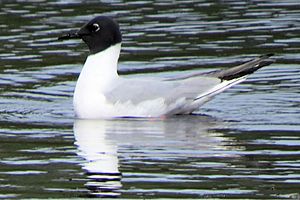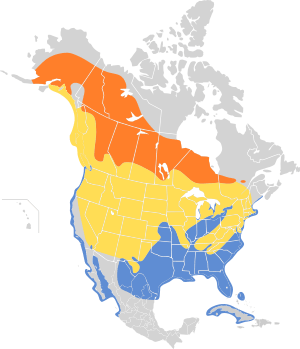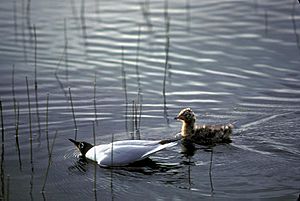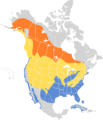Bonaparte's gull facts for kids
The Bonaparte's gull (Chroicocephalus philadelphia) is a small and graceful bird. It belongs to the gull family and lives mostly in northern North America. These gulls are about 28 to 38 cm (11 to 15 in) long, making them one of the smallest gull species. Their feathers are mostly white, with grey on their backs and wings. When it's time to breed, they get a cool slate-grey "hood" on their heads. Male and female Bonaparte's gulls look very much alike.
Quick facts for kids Bonaparte's gull |
|
|---|---|
 |
|
| Adult breeding | |
 |
|
| Adult non-breeding | |
| Conservation status | |
| Scientific classification | |
| Genus: |
Chroicocephalus
|
| Species: |
philadelphia
|
 |
|
| Synonyms | |
|
|
Contents
What's in a Name? The Story of Bonaparte's Gull
When the Bonaparte's gull was first described in 1815, it was given the scientific name Sterna philadelphia. This name placed it with medium-sized terns. Later, most scientists put it in the Larus genus, which was a common group for many gulls.
However, in 1858, a scientist named George Newbold Lawrence moved it to the genus Chroicocephalus. Recent studies using DNA have shown that this gull fits well with other "masked gulls." These studies also found that the Bonaparte's gull is closely related to the slender-billed gull. Because of this, the American Ornithologists' Union moved it to its current genus in 2008. This species is unique, meaning there are no different types of it across its range.
Who Was Bonaparte?
The gull is named after Charles Lucien Bonaparte. He was a French bird expert and the nephew of the famous French emperor Napoleon Bonaparte. Charles Bonaparte spent eight years in America. He helped us understand more about how birds are named and grouped.
What Do the Scientific Names Mean?
The genus name, Chroicocephalus, comes from two Greek words. Chroikos means "colour," and kephalē means "head." This name refers to the dark heads that gulls in this group have during the breeding season.
The species name, philadelphia, is a Latin word. It means "from Philadelphia." This is because the first example of this bird was found near Philadelphia.
How to Spot a Bonaparte's Gull
Bonaparte's gull is one of the smallest gull species. Only the little gull and Saunders's gull are smaller. Adult gulls are about 28 to 38 cm (11 to 15 in) long. Their wings can spread 76–84 cm (30–33 in) wide. They weigh around 180–225 g (6.3–7.9 oz).
Male and female gulls look the same. However, males are usually a bit heavier. Bonaparte's gulls are smaller than other gulls with dark hoods in North America. They have smaller bodies, heads, and bills.
What Do They Look Like?
These gulls have grey feathers on their backs and white feathers underneath. Their wingtips are black on top and pale underneath. When it's breeding season, they get a dark, slaty black "hood" on their heads. This hood disappears when they are not breeding. Their short, thin bill is black, and their legs are orangish-red.
Young Bonaparte's gulls in their first summer look similar to how they do in their first winter. Their feathers are just a bit paler. Very few young gulls get a dark hood in their first summer. If they do, it's not as dark as on adult breeding gulls.
Where Do Bonaparte's Gulls Live?
Bonaparte's gulls breed in the boreal forests of southern Alaska. They also breed across much of western Canada. Their breeding range extends east to central Quebec. It goes south to about 120 mi (200 km) from the United States/Canada border.
They prefer open areas, not dense forests. You can find them at the edges of bogs, fens, marshes, ponds, or on islands. They usually build their nests within 60 m (200 ft) of open water.
Where Do They Go in Winter?
In winter, these gulls fly to the coasts of North America. They also spend winter in the Great Lakes region. Sometimes, a few gulls fly far away to western Europe and the Azores. There, they often join groups of black-headed gulls. In 2017, a pair was even seen breeding in Iceland.
How Do Bonaparte's Gulls Behave?
Bonaparte's gulls are migratory birds. This means they travel long distances. Most of them fly east or west to coastal waters or the Great Lakes. They are very graceful when they fly, often looking more like terns.
What Do They Eat?
Like most gulls, Bonaparte's gulls eat many different things. Their diet changes throughout the year and from one year to the next. During the breeding season, they mainly eat insects. They are known to quickly gather in large groups when termites fly out. They circle above the swarm and hover to catch the insects in the air.
They also gather in large numbers to eat the eggs of salmon when they are spawning. The gulls land on the water and may even dive to catch eggs floating by. During migration and winter, they eat fewer insects. Instead, they eat fish, small crustaceans, mollusks, and other sea creatures. They have even been seen stealing earthworms from other birds.
How Do They Raise Their Young?
Bonaparte's gulls start breeding when they are two years old. They are believed to stay with one partner for life. The breeding season begins in mid-June. Pairs perform special flights to attract each other. They call loudly and dive at each other. Then, they land on a branch.
They face each other, raising their neck feathers and wings slightly. They scream with their bills wide open, bobbing up and down. This can last for several minutes. After this, they might sit quietly together before separating.
They raise one group of chicks per year. They nest alone or in small colonies of 2–20 pairs. Nests are usually 30–50 m apart. Unlike most gulls, Bonaparte's gulls usually nest in trees. They almost always choose conifer trees like black spruce or jack pine.
Both parents help build the nest. It's a platform made of small sticks, sometimes with moss or other plants. The nest is about 25 cm (9.8 in) wide. Most nests are 3–6 m (9.8–19.7 ft) above the ground. They are also within 60 m (200 ft) of open water. Sometimes, nests are found as low as 1.5 m (4 ft 11 in) or as high as 15 m (49 ft). They are rarely on the ground.
Adult gulls bravely defend their nests. They chase away large predators like hawks and common ravens, and even humans.
Eggs and Chicks
The female lays a clutch of 2–4 eggs, but most nests have 3 eggs. The eggs are smooth and slightly shiny. They are about 49 mm × 34 mm (1.9 in × 1.3 in) and weigh 28.5 g (1.01 oz). Their color can be pale green, olive, or buff. They may have spots or blotches of brown, grey, or black.
Both parents sit on the eggs to keep them warm. This is called incubation. It lasts for 22–24 days. Bad weather can really affect how many eggs hatch. In one study, more than half of the eggs were blown out of nests during storms. Only 42% of eggs hatched.
Baby Bonaparte's gulls are born with soft, fluffy feathers. Their eyes are already open. They are yellowish-buff with dark brown spots on their backs and heads. Their bill is blue-black with a pink base. Their legs and feet are pinkish-buff.
Young birds usually leave the nest within 2–7 days after hatching. They jump out and follow their parents to the nearest water. Both parents take care of the young. It's not known exactly how long it takes for the young to learn to fly. Bonaparte's gulls can live for up to 18 years.
What Do They Sound Like?
Bonaparte's gull has a voice that sounds nasal and raspy. Their calls are often described as cherr or cheeer.
Protecting Bonaparte's Gull
The Bonaparte's gull is doing well. Its population is growing, and it lives across a very large area. Because of this, the International Union for the Conservation of Nature lists it as a species of least concern. This means it is not currently at risk of disappearing.
In North America, the Migratory Bird Treaty Act protects it. This law helps protect many bird species that travel between countries. Since it only rarely visits Europe and Africa, it is not protected by a specific agreement there. Peregrine falcons are known to hunt Bonaparte's gulls.
Like many animals, these gulls can have tiny creatures living inside or on them. These are called parasites. For example, a tiny worm-like crustacean called Reighardia sternae can sometimes be found in the gull's air sacs. They can also carry different types of lice on their feathers.
See also
 In Spanish: Gaviota de Bonaparte para niños
In Spanish: Gaviota de Bonaparte para niños
Images for kids






